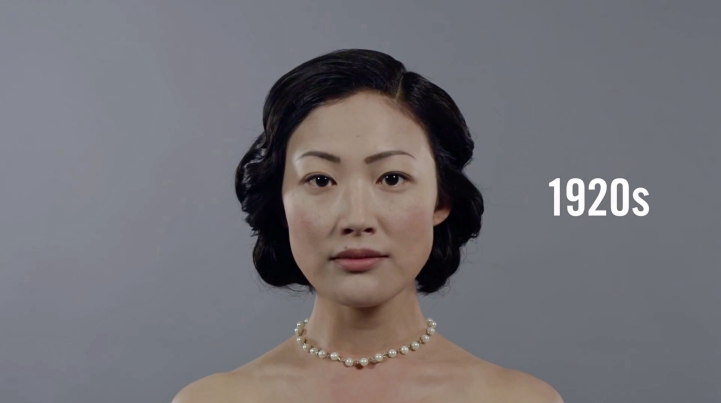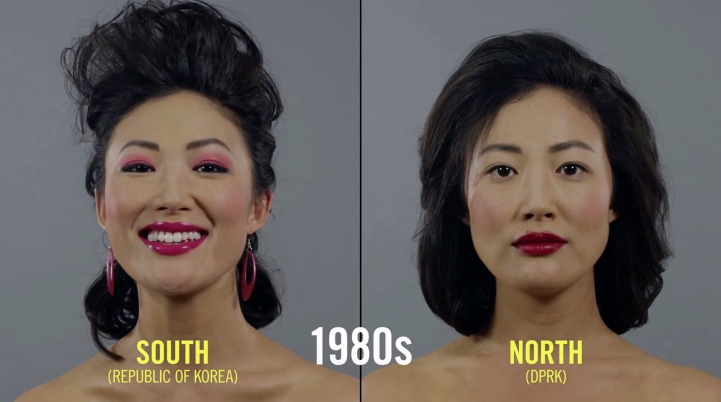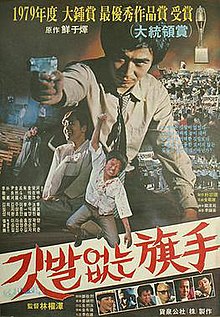Blog Post 3 - The 20's and the 80's
While I would love to get into the all the years between the Joseon era and today, it would make for a very long series of blog posts (which I'm hoping to avoid with this one) which would be pretty boring. Instead, I picked out two different time periods which I thought had significant differences and influences in contrast to both modern day and Joseon Korea.

From 1910 to 1945, the Japanese had occupied Korea, which many people considered a rough time in Korea history. One of the main reasons why was due to the fact that Koreans were not allowed to wear Hanboks during this time (which is the traditional Korean dress, as mentioned in the last post).
The 1920's in Korea were an interesting time. Despite being relatively close in time to the Joseon period, the styles were vastly different during the two times, mostly due to the fact that Korea was occupied by Japan during this time.
The picture of the left shows a Korean woman wearing what would be a Japanese twist on the Korean Hanbok. No longer were they just the same as they used to be, but rather they were tweaked so that they look a lot more like the Japanese Kimono in nature. The woman on the right is from the same time period, but instead of opting for the traditional look, she wears something more similar to what the women in the west would be wearing. This is because during this time, while Japanese influence greatly dominated Korea, this is around the time that the Western influence started to leak in.
For the facial features, at the moment, they remained around the same as what was considered the ideal woman. Confucianism still remained as one of the largest philosophies in Korea, which meant that there was the same ideology that you shouldn't change any of your outwards appearance, as everything your parents gave you is a gift.
However, the upper class began to follow in the steps of the US a bit more, with both women and men starting to cut their hair. The Cut, a fashion Youtube channel, has a series called 100 years of beauty. In their Korean installment, this is the look they created for their 1920's model.

It wasn't until the Japanese had left Korea that Western influence really began to flourish over the Koreans. By the 70's, they had pretty much the same style, with the confucianism philosophy starting to take a backseat to fashion. With the 80's, came everything you would imagine with the 80's of the US - brightly colored eye makeup, the thick glasses, and the big hair.
However, the upper class began to follow in the steps of the US a bit more, with both women and men starting to cut their hair. The Cut, a fashion Youtube channel, has a series called 100 years of beauty. In their Korean installment, this is the look they created for their 1920's model.

While their looks aren't all completely what I would call beauty in Korea (especially when it comes to modern day Korea) I do think they did a good job with some of the older generations.
It wasn't until the Japanese had left Korea that Western influence really began to flourish over the Koreans. By the 70's, they had pretty much the same style, with the confucianism philosophy starting to take a backseat to fashion. With the 80's, came everything you would imagine with the 80's of the US - brightly colored eye makeup, the thick glasses, and the big hair.
 |
| 100 Years of Beauty took a look at the difference between North and South Korea's styles once they spilt up. As for this blog (and the sake of my own sanity, since it's hard enough to find some of this information) we're going to be sticking to just looking at South Korea. |
There's even a very popular drama in Korea, called Reply 1988, in which they replicate a lot of the styles seen in Korea in the 80's. It's very similar to that of the US in many aspects, however there is one thing I found in my research.
 |
| Family portrait taken for the drama series Reply 1988 |
It was in the end of the 70's and towards the beginning of the 80's that Korea's plastic surgery industry started to bloom. If you didn't already know, Korea is notorious for their use of plastic surgery, the most common being the double eyelid procedure, that's so common, it's not even considered 'plastic surgery' as most beauty salons offer this (in which the skin above the eye is stitched together, to create the crease that basically the whole world but Koreans seem to have). Procedures like double eyelid surgery and rhinoplasty (nose jobs) is so common, that some girls are given this operations to them as graduation gifts from their parents.
While fashion might be one thing, it's the actual facial features and body shape that differs so greatly from Western standards. It's ironic, considering that the biggest reason why Korean beauty standards differ so greatly from Western ones, is because they're trying to copy Westerners. The sloping nose, the bigger eyes, the whiter skin - these are all things they picked up from the West, as more and more foreigners came into Korea.
When it comes to deconstructing these beauty standards and ideals, I think there had to be a variety of factors at work here. First of all, let me touch on Confucianism again. While this philosophy was losing it's know-all be-all power over Korea, I do think that there was something from this that had to do with what women are expected to be. The delicate, innocent, and pure look that a lot of Korean girls are expected to have can derive from the expected role that women hold (refer back to my last blog for more details, but mostly about how women must be gentle and sweet). This might be one of the root causes for the very feminine expectations that girls in Korea are expected to uphold.
Another thing I took into consideration is actually genetics. One of the big things that is very different between the West and Korea is body image. The West is a lot more open to what is considered beautiful, at least in comparison to Korea. While skinny is considered to be pretty in most of the world, our Western standards also dictate that women with big butts, large hips, and thick thighs are also desirable. However, this isn't the same in Korea.

Take Hwasa from the K-pop girl group MAMAMOO for example (above). Her body type fits into what Western fans find beautiful - tanned skin, thick thighs, and wide hips. But to Koreans, she's known among the K-netizens to be the 'ugly fat' one in MAMAMOO, as she isn't as wafer-thin as the other girls, nor does she fit into the category of 'doll-like beauty' that Korea expects.
Kong, Daniel. "Unmasking East Asia's Beauty Ideals." The Business of Fashion. September 21, 2016. Accessed December 18, 2018. https://www.businessoffashion.com/articles/global-currents/unmasking-east-asias-beauty-ideals.
Another thing I took into consideration is actually genetics. One of the big things that is very different between the West and Korea is body image. The West is a lot more open to what is considered beautiful, at least in comparison to Korea. While skinny is considered to be pretty in most of the world, our Western standards also dictate that women with big butts, large hips, and thick thighs are also desirable. However, this isn't the same in Korea.

Take Hwasa from the K-pop girl group MAMAMOO for example (above). Her body type fits into what Western fans find beautiful - tanned skin, thick thighs, and wide hips. But to Koreans, she's known among the K-netizens to be the 'ugly fat' one in MAMAMOO, as she isn't as wafer-thin as the other girls, nor does she fit into the category of 'doll-like beauty' that Korea expects.
| Hwasa on the far right next to her other members Moonbyul, Solar, and Wheein |
Now, relating this back to my point about genetics - if you haven't noticed, most Asians (most, not all) are usually more petite in size compared to other races. This is due to a gene mutation called EDAR, which only East Asians carry. This is why Asians commonly have less body fat, and less body hair. The study showed that 90% of East Asians (Chinese, Japanese, and Korean) carry this trait, while 70% of South-East Asians (Thai, Malaysian, Indonesian) carry this gene. This is why not all (yet most) Asians have the similar body type.
Due to the naturally more petite size of Asians, this would point to why it's considered to be beautiful if you are slimmer in nature. This is what set the Asians apart from the Americans as they descended into the 1980's, as the roots of modern day beauty began to form. The paler skin was always considered to be beautiful in Asia - it meant that you were rich, as you didn't have to work outside, but this was only hammered home even more when fair-skinned Europeans showed up.
The double-eyelid comes from the whole Confucism philosophy once again. Women are expected to be 'cute', and a study showed that the reason why we find babies and baby animals cute is because of their big eyes. Humans are naturally hardwired to find things with big eyes (along with small hands and feet) cute, for some reason. Your eyes don't grow as you grow, which is why a baby is much cuter than a fully-grown person.
The double-eyelid gives the illusion of bigger eyes, which equals a cuter face.
As for men... I know this blog is much more focused on women (because I could hardly find any research about men's beauty standards), but I've discovered a few tidbits about what was considered to be attractive in men in the 1980's.
It's vastly different from the pretty boys of Korea right now. Due to the media influence in movies that came out during this time, the more prominent definition of masculinity was what Koreans found to be attractive. Men were shown to be tough, strong, and muscular, partially due to the number of action movies, and partially due to the mandatory military service that came into play around this time (due to the rising tensions between North and South Korea)
 |
| A movie poster for The Hidden Hero, a South Korean movie that came out in 1980 |
Going forwards, I hope to make one final copy of a timeline of Korean beauty standards and how they've evolved over the years, complete with pictures, explanations to culture, and more in-depth analysis from my primary source, as well as my own connections.
Works CIted
"Flowerboys and the Appeal of 'soft Masculinity' in South Korea." BBC News. September 05, 2018. Accessed December 18, 2018. https://www.bbc.com/news/world-asia-42499809.
"Stunning Beauty Standards For Women And Men Throughout History." Trendchaser. September 06, 2017. Accessed December 18, 2018. https://www.trend-chaser.com/history/stunning-beauty-standards-for-women-and-men-throughout-history/?chrome=1&adblock=1.
Asiaone. "How Asian Beauty Standards Have Changed over 100 Years." Sixteen Schools Do Away with Primary 1 Exams. January 20, 2016. Accessed December 18, 2018. http://www.asiaone.com/women/how-asian-beauty-standards-have-changed-over-100-years.
Choi, Eunji, "Korean fashion media, beauty ideals, and colorism: Examining the prominence of whiteness between 2013 and 2017 in Céci magazine" (2018). Graduate Theses and Dissertations. 16331.
Holyst, Emma Weiss, "Fashioning Seoul: Everyday Practices of Dress in the Korean Wave" (2018). Senior Projects Spring 2018. 172.
Kong, Daniel. "Unmasking East Asia's Beauty Ideals." The Business of Fashion. September 21, 2016. Accessed December 18, 2018. https://www.businessoffashion.com/articles/global-currents/unmasking-east-asias-beauty-ideals.
Soh, Chunghee Sarah. "South Korea." Countries and Their Cultures. Accessed December 18, 2018. https://www.everyculture.com/Ja-Ma/South-Korea.html.
Valérie Gelézeau. The body, cosmetics and aesthetics in South Korea The emergence of a field of research. 2015.
Wade, Nicholas. "East Asian Physical Traits Linked to 35,000-Year-Old Mutation." The New York Times. October 19, 2018. Accessed December 18, 2018. https://www.nytimes.com/2013/02/15/science/studying-recent-human-evolution-at-the-genetic-level.html.
Zhang, Jenny. "Different Perceptions of Beauty Over 100 Years in North and South Korea." My Modern Met. November 18, 2017. Accessed December 18, 2018. https://mymodernmet.com/the-cut-100-years-of-beauty-korea/.
I thoroughly enjoyed reading your blog! I noticed that you used pictures from the "100 years of Korean beauty" video. I think the video would be a great component to show to the class during your presentation. This would maximize student engagement and add a visual component to the research you have already conducted.
ReplyDeleteI have learned so much from your blogs. It is fascinating how all societies seem to have their own standards of beauty and that these standards often seem to require that we change something about ourselves. I have never been to Korea, but when I visited China I remember seeing whitening creams/commercials everywhere. It is interesting that this was still so valued in China whereas in North America people are using self tanner. I didn't know about the gene mutation, and I found that fascinating. Very engaging, well researched and thoughtful blog post!
ReplyDeleteDeborah, I really enjoyed reading your blog and learning about the history behind many of the beauty standards today. It reminded me of my trip to Vietnam when I was really young, the weather was extremely hot and I was always wearing shorts and t-shirts, but everyone else wore long sleeves and long pants because they were afraid to get a tan from the sun. Since I was born in Canada I had been influenced by western beauty standards and saw nothing wrong with tanning. I find it really interesting how Western features such as double eyelids greatly influence Korean beauty, but at the same time Korea has developed many of their own standards. It may be interesting to look into Korean beauty products/skincare and compare them to that of Western beauty products/skincare, or products/skincare from around the world, or even beauty trends such as the glass skin appearance. Looking at beauty standards also makes you wonder whether beauty is subjective or objective, because to some extend there seems to be a general consensus of what features are more admirable than others (e.g big eyes).
ReplyDeleteFor quick router access tools and admin dashboard shortcuts check:
ReplyDelete19216811 and
1921681001.
Both help you reach router login pages quickly for password, SSID, or firmware changes.